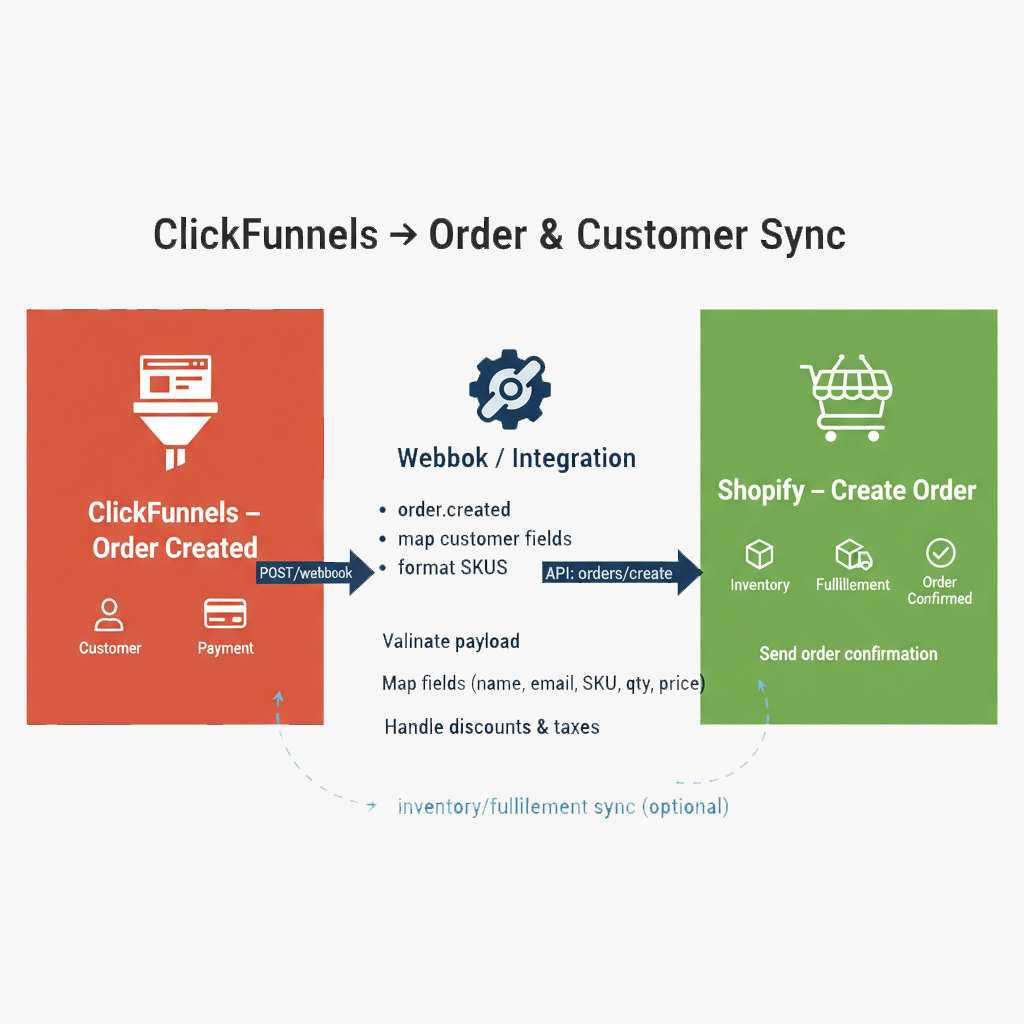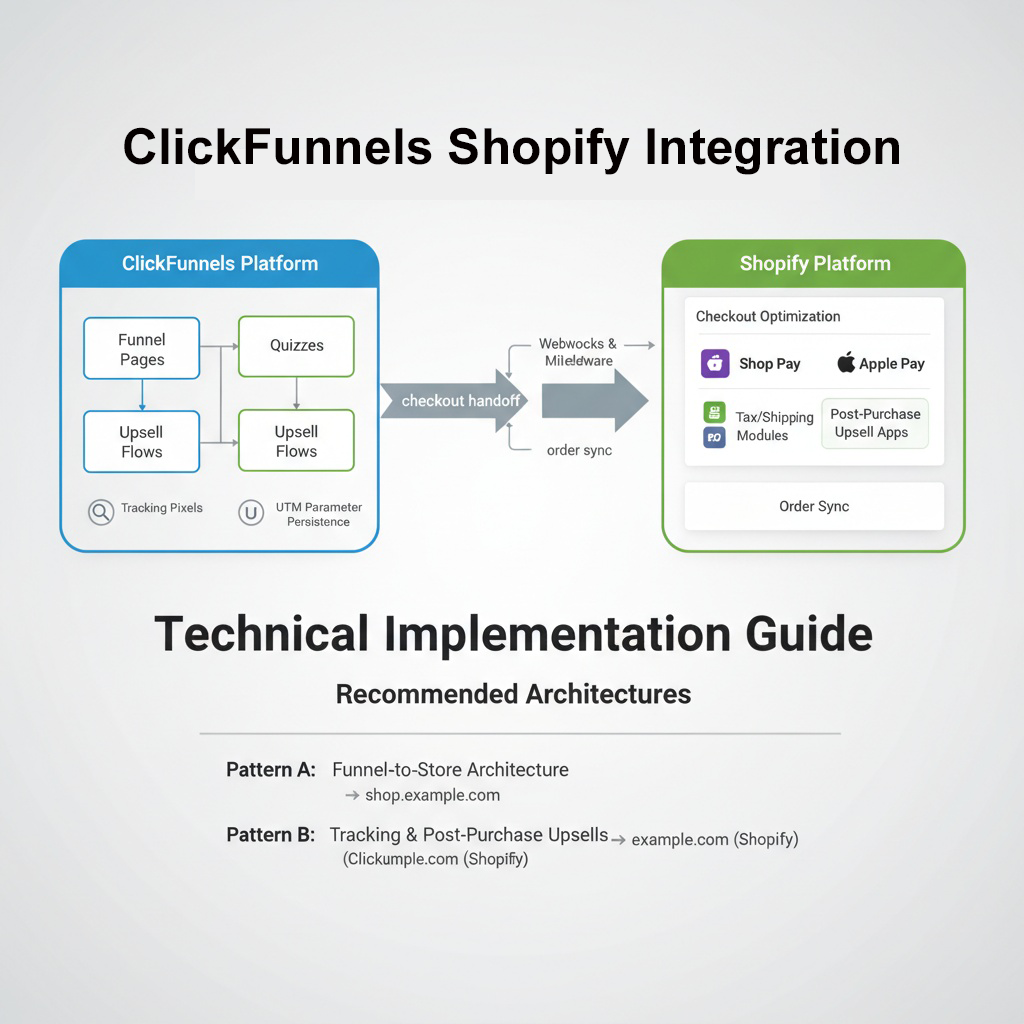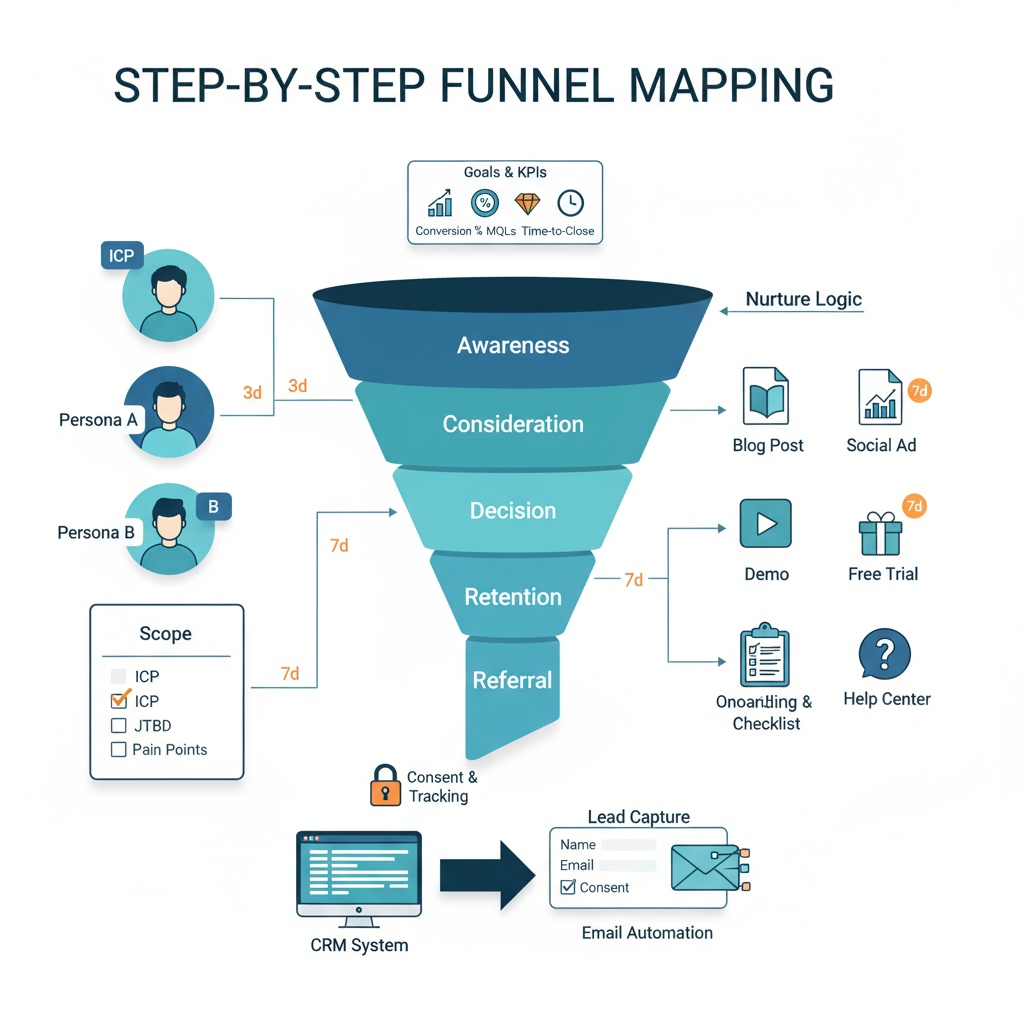ClickFunnels vs Shopify: Don’t switch—integrate for funnel-to-store scale
Founders and marketers often frame clickfunnels vs shopify as an either/or choice. For growth-focused ecommerce, the smarter move is integration. Run ClickFunnels for agile funnel building, split testing, quizzes, and conversion lifts—while Shopify powers the commerce engine you trust for catalog, inventory, taxes, fulfillment, and a world-class checkout.
This technical guide shows how to combine both platforms without migrating or rebuilding your stack. You’ll get precise architectures, actionable implementation steps, tracking blueprints, checkout handoffs, and post-purchase upsell patterns that compound AOV and attribution clarity.
Who is this for?
AI agencies and ecommerce founders who need the speed of funnel experimentation, deep analytics, and complex upsell logic, while depending on Shopify for compliance, payments, and operational reliability.
ClickFunnels Shopify integration: what you’ll implement
- Reference architectures for funnel-to-store flows, including checkout handoffs and order syncs
- Step-by-step setups for UTMs, click IDs, GA4 cross-domain tracking, server-side tagging, CAPI, and Meta Pixel deduplication
- Offer mapping, discount logic, and product/variant alignment between systems
- Handoff mechanics that preserve attribution across domains and devices
- Post-purchase upsells and LTV plays leveraging Shopify’s order system
When a shopify funnel builder alone isn’t enough
- You need aggressive multi-step funnels, presell pages, advertorials, and 1-click OTOs
- You want faster A/B testing than theme-bound or page-app constraints
- You rely on Shopify checkout optimization (wallets, shipping rates, tax/VAT) but want pre-checkout freedom
ClickFunnels for eCommerce + Shopify checkout optimization: the core advantages
- Funnel velocity: launch, iterate, and personalize flows without touching your storefront theme
- Commerce stability: keep Shopify’s payment compliance, inventory sync, and fulfillment workflows
- Clean attribution: unify UTMs, fbp/fbc, client IDs, and event_id across platforms to avoid double fires
- Revenue lift: orchestrate pre- and post-purchase upsells that don’t break reconciliation or compliance
In the sections that follow, you’ll map the right integration pattern to your catalog complexity, analytics requirements, and team workflow, then implement it with production-grade QA steps and tracking hygiene.
ClickFunnels vs Shopify Integration: A Decision Framework That Prevents Costly Rebuilds
Choosing between ClickFunnels and Shopify is often the wrong question. The right question is whether your growth model benefits from a dual-stack where ClickFunnels drives rapid testing and pre-sell logic while Shopify anchors catalog, taxes, payments, and fulfillment. If you are weighing clickfunnels vs shopify because of scaling pressure, compliance, or experimentation velocity, decide using signals rather than preference.
| Signal | Integrate both | Migrate to Shopify with a funnel builder | Migrate to ClickFunnels-first |
|---|---|---|---|
| Funnel velocity | Daily A/B tests, quiz or presell steps, complex OTO paths | Moderate testing inside Shopify themes | Single offer, few SKUs, launch-centric promos |
| Catalog complexity | Many variants, bundles, real-time inventory | Manageable catalog with native Shopify apps | Minimal SKUs, external fulfillment ok |
| Checkout needs | Wallets, shipping rates, VAT, tax compliance globally | Standard Shopify checkout is sufficient | Nonstandard checkout logic before payment |
| Attribution depth | UTMs, click IDs, server-side events, deduplication | Basic channel attribution acceptable | Funnel-centric analytics are primary |
| Integration tolerance | Comfortable with webhooks and middleware QA | Prefer one stack to reduce ops load | Engineering support available for sync scripts |
| Compliance posture | PCI and privacy gates handled by Shopify | Prefer centralized compliance | Accept added reconciliation and tax mapping |
If your answers skew toward integration, build a plan that treats ClickFunnels for ecommerce as your testing layer and Shopify as your transaction source of truth. For a deeper background on capabilities and pricing contrasts, see our in-depth comparison of funnels vs full e-commerce platforms in ClickFunnels vs Shopify in 2025.
When Integration Wins Over Migration
Certain operating realities make a dual-stack the pragmatic choice:
- You run paid social at scale and need precise click ID capture, UTMs, server-side event forwarding, and event deduplication.
- You iterate offers weekly and need a launchpad for advertorials, quizzes, and A/B split tests without touching theme code.
- You rely on Shopify checkout optimization for wallets, tax calculation, and regional shipping rates that must remain stable during tests.
- You manage many SKUs, subscriptions, or bundles that need Shopify’s inventory, fulfillment, and customer service workflows.
If this is your world, clickfunnels shopify integration keeps speed and control without breaking accounting, chargebacks, or tax filing. To see common pitfalls and integration scope, review Integrating Shopify With ClickFunnels on ClickFunnels Support and Aureate Labs’ comparison and integration primer.
Team and Stack Readiness Before You Start
Before you wire anything, confirm your foundation:
- Accounts and domains: Shopify and ClickFunnels live environments, SSL on both, and clear subdomain strategy so traffic paths are predictable.
- Tooling: a Shopify funnel builder app if you plan Shopify-first tests, post-purchase upsell apps, GTM, GA4, Meta Pixel, and server-side tagging.
- Middleware: Zapier, Make, or a lightweight custom service for webhooks and API retries.
- Skills: page building in both systems, Google Tag Manager, event mapping, Shopify Admin and Orders API literacy, and QA discipline.
For implementation viewpoints and app choices, compare guidance from Avada Commerce on using ClickFunnels with Shopify and Hevo Data’s integration walkthrough.
Architecture Overview: Three Patterns That Cover 95 Percent of Use Cases
You will implement one of three reference patterns depending on funnel control vs operational simplicity. Pattern A routes from ClickFunnels pages into Shopify checkout. Pattern B keeps checkout in ClickFunnels, then syncs paid orders back to Shopify. Pattern C uses a native Shopify funnel builder app to stay within one platform for checkout while still enabling campaign-specific pages.
- Pattern A is ideal when you want Shopify checkout optimization without sacrificing funnel speed.
- Pattern B is chosen when you need pre-payment upsells or specialized checkout logic and you can manage order sync rigor.
- Pattern C is a lower-integration path inside Shopify for small teams that still want structured funnels.
For a side-by-side view of tradeoffs and build steps, the next section breaks down each pattern with implementation detail.
Visualizing Order and Customer Sync Across Systems

This high-level flow shows how a checkout or order event in ClickFunnels is captured, normalized, and created in Shopify with clean customer, line items, and totals. The dashed return path reminds you to consider optional inventory or fulfillment updates back to your middleware if you need bidirectional awareness for analytics and support.
For a crisp blueprint of webhooks, payload validation, and mapping nuances, see the ClickFunnels & Shopify integration guidance and the Fittle Project’s practical notes on common sync gotchas.
Data, Identity, and Attribution Across the Funnel
Clean attribution is the difference between guesswork and profit. Plan your tracking before you publish the first page.
- Identity capture: collect UTMs, fbclid, gclid, ttclid, and session identifiers on the first ClickFunnels touch. Persist them through to checkout or order creation.
- Cross-domain analytics: configure GA4 cross-domain so client identifiers survive the handoff between funnel subdomain and shop domain.
- Pixel strategy: pre-checkout events fire on ClickFunnels pages. Purchase events fire at the Shopify thank you page if checkout is in Shopify. Use consistent event_id to deduplicate across browser and server.
- Server-side events: pick a single source of truth per event type. Shopify’s native CAPI can own purchases while your funnel stack forwards pre-checkout events. Match fbp, fbc, and customer identifiers to maximize attribution.
If you need a refresher on platform capabilities, review ClickFunnels’ integration guide and Aureate Labs’ comparison for mechanics and limitations.
Checkout, Compliance, and Payment UX
Shopify checkout optimization is nonnegotiable for most brands once wallets and regional tax rules come into play. Even if your pre-sell logic lives in ClickFunnels for ecommerce, the last mile should respect compliance and customer expectations.
- Wallets and accelerated checkout: Shop Pay, Apple Pay, and Google Pay conversion lifts are measurable and compound with scale.
- Taxes and shipping: automatic tax calculation, duty handling, and carrier rates reduce refund friction and support load.
- Fraud and PCI scope: keeping payments inside Shopify limits your exposure and simplifies audits.
When you must control the order of offers before payment, be prepared to manage tax, discount, and shipping calculations in your order sync. HulkApps’ overview on seamless ecommerce automation is a useful perspective on operational details.
Analytics Model and Reporting Alignment
Decide where source-of-truth numbers live, then instrument your stack to support that choice.
- Source-of-truth selection: orders and revenue typically anchor in Shopify. Funnel conversion rates and pre-click metrics anchor in ClickFunnels. Reconcile on order number and timestamp.
- Event taxonomy: define standard event names, parameters, and user properties. Make sure both platforms use consistent naming to simplify dashboards.
- Deduplication: ensure each purchase has a unique event_id and that server-side and browser events share identifiers to avoid double counting.
- QA instrumentation: log UTMs at the order level in Shopify via attributes or metafields so you can audit campaign performance without guesswork.
For broader marketing system interoperability, see the ClickFunnels integrations guide which outlines how events push through downstream tools.
Implementation Planning Checklist Before You Touch a Page
Lock decisions in writing to prevent drift during build and QA:
- Pattern selection: A for handoff to Shopify checkout, B for ClickFunnels checkout with Shopify order sync, or C for Shopify-only with a page builder.
- Domain map: funnels subdomain vs shop domain, SSL, and consent banners mirrored.
- Product map: SKUs, variants, bundles, subscription logic, and discount rules defined in Shopify.
- Tracking design: UTMs, click IDs, event_ids, cross-domain settings, server-side endpoints.
- Middleware: retry strategy, idempotency keys, error logging, and monitoring.
- Post-purchase: upsell or cross-sell app in Shopify, receipt and transactional email routes, subscription proration behavior.
- Legal: privacy notices, cookie consent, GDPR/CCPA preferences synced across domains.
For teams who attend community events, the Funnel Hacking Live 2025 guide includes planning tips that can help align stakeholders and timelines around go-live windows.
Risk Management and QA Scenarios You Should Script
Prevent silent errors by rehearsing edge cases the same way you test winning creatives.
- Multiple offers and mixed shipping: verify totals and taxes for bundles, digital plus physical, and free shipping thresholds.
- Currency and region: test international shoppers, currency displays, and tax inclusivity.
- Discounts and gift cards: ensure codes calculate once and carry through from funnel to checkout.
- Attribution integrity: confirm UTMs and click IDs land in Shopify orders, and that purchase events deduplicate across browser and server.
- Refunds and cancellations: check how refunds in Shopify reflect in your funnel analytics and LTV models.
For more context on operational readiness, the ClickFunnels and Shopify integration overview from Aureate Labs is a helpful primer, and Avada Commerce summarizes practical app considerations.
What Comes Next in the Technical Build
With your decision framework, data plan, and QA scenarios in place, the next section moves from architecture choices into hands-on implementation. You will see how Pattern A routes ClickFunnels pages into Shopify checkout and how Pattern B collects payment in ClickFunnels then synchronizes orders to Shopify for inventory and fulfillment.
Architecture decisions at scale: when Pattern A or B actually wins
Traffic mix, SKU structure, and compliance posture decide more than preference. Treat Pattern A as your default for paid social and TikTok clicks where wallets and taxes must be bulletproof across regions. Shift to Pattern B only when you need pre-payment offer sequencing that Shopify cannot replicate, like nested upsell logic, multi-offer price testing, or gated launch funnels.
- Choose Pattern A if 70 percent or more of your traffic hits mobile, you rely on Shop Pay or Apple Pay conversion lifts, you run multiple markets, or finance insists on unified tax reporting.
- Choose Pattern B if a single campaign must split buyers through three or more 1-click offer paths before capture, if you need strict control over decline handling, or if you must run timeboxed OTO logic that conflicts with Shopify checkout rules.
Pattern A advanced build: handoff fidelity, currency control, and identity continuity
Focus on three hard problems: preserving identity across domains, maintaining correct market pricing, and writing rich order context back into Shopify without brittle hacks.
Identity continuity
Use GA4 linker on ClickFunnels to append _gl parameters, then enable cross-domain linking with the shop hostname. Carry the GA client ID into Shopify via query params and store it as an order attribute for analytics joins.
Capture fbclid, fbp, fbc, gclid, and ttclid in ClickFunnels with first-party cookies. Append them to the Shopify checkout URL using attributes[…] so they land in order attributes. Align Meta Purchase dedup by passing a consistent event_id from ClickFunnels to the final thank you event.
Deploy GTM on both properties. Fire InitiateCheckout from the ClickFunnels last pre-checkout step. Fire Purchase exclusively on Shopify’s order status page or via Shopify’s Customer Events for Plus.
Market and currency alignment
Do not force currency in the checkout URL. Let Shopify Markets set presentment currency based on geo, domain, or preference, or you risk mismatched pricing against your ad creative.
If an offer uses a fixed localized price, create separate variants per market and route to the correct variant ID. Avoid dynamic discounting across markets unless you have tax parity modeled.
Verify shipping profiles and tax registrations per market with a test matrix. Price inconsistencies from velocity discounts or tiered shipping appear first on mobile wallets.
Order context and discount integrity
Encode funnel step, creative ID, audience cohort, and quiz results into line item properties rather than notes. Properties travel better through returns apps and post-purchase flows.
Prefer fixed-amount discount codes tied to specific variants to prevent unpredictable percentage stacking when customers add extras in checkout. Validate discount stacking behavior with automatic discounts turned on and off.
Abandonment and recovery
Trigger Shopify’s abandoned checkout automations by routing to checkout early in the flow, but only after you’ve collected email in ClickFunnels. Sync the email to Shopify via a customer create endpoint before handoff if the offer requires browse abandonment campaigns.
Track abandoned handoffs by logging a synthetic event in your data warehouse when a user clicks the checkout link, then reconcile against Shopify checkouts created. The delta exposes pre-checkout leakage or bot activity.

QA that doesn’t break under load
- Use Playwright to simulate UTM-rich sessions across Safari and Chrome with ITP on. Assert that order attributes in Shopify include the original click IDs and that purchase dedup fires once in Meta and GA4.
- Test three error paths: expired discount codes, out-of-stock variants after handoff, and currency switching mid-checkout. Add a fallback route to cart if a variant ID fails validation.
For authoritative references on this approach, see the Shopify integration guide from ClickFunnels support and the Aureate Labs comparison that outlines handoff tradeoffs.
Pattern B advanced build: resilient order sync, payouts, and returns
CF-first checkout introduces a new source of truth for transactions. Architect for idempotency, reconciliation, and compliance from day one.
Event ingestion and queuing
Subscribe to ClickFunnels purchase and upsell webhooks. Push events into a queue with a stable idempotency key composed of funnelid + ordernumber + step_index. Only your worker should talk to the Shopify API.
Store a normalized order schema: items, discounts, tax lines, shipping lines, payment gateway, fees, and timeline of OTO accept/decline. This enables accurate downstream refunds and analytics.
Order creation on Shopify
Create orders as paid with the Orders API and include a custom gateway name like ClickFunnels. Post a Transaction object with the exact charge amount and fees for margin clarity.
Map line items by SKU to Shopify variant IDs. If your funnel bundles virtual SKUs, expand them into their component variants and store the bundle definition in properties for support and returns logic.
Write tax lines explicitly if you calculate tax in ClickFunnels. If not, set taxes_included appropriately and document the jurisdiction logic. Misaligned tax lines will break finance reconciliation.
Shipping, fulfillment, and inventory
Deduct inventory on order creation. If CF collected separate shipping fees, map to a Shopify shipping line with a recognizable title for carrier cost analysis.
For split shipments, create multiple fulfillments in Shopify after sync using location routing rules. Avoid a single all-items fulfillment record if your 3PL relies on location-based triggers.
Refunds, partials, and chargebacks
Centralize refunds in Shopify. When a refund is issued, mirror it back to ClickFunnels through your middleware to keep LTV consistent. Do not allow frontline agents to refund in both tools.
Store chargeback signals with the order and flag high-risk patterns to your funnel team. Decline handling in CF should branch to a save offer with reduced AOV rather than a hard exit where appropriate.
Subscriptions and recurring revenue
If the product requires Shopify Subscriptions, do not capture the initial payment in ClickFunnels. Shopify contracts require Shopify Checkout. Use Pattern A or a Shopify-first funnel builder instead.
If you must run recurring in CF, maintain an external subscription ledger and sync only initial and renewal orders into Shopify for inventory and customer service. Document cancellation rights clearly to avoid double billing.
Analytics and compliance
Send Purchase server-side from your middleware to Meta and GA4 using the same event_id as the client event emitted by ClickFunnels. Deduplicate in platforms, not in your code, to reduce drift.
Honor consent captured in ClickFunnels by passing consent state into Shopify and your server-side events. For GDPR and CCPA, use regional enforcement and suppress marketing identifiers when consent is denied.
For a walkthrough of webhook-based setups, the Hevo Data tutorial and the Avada guide provide additional patterns. The Fittle Project overview helps evaluate tool choices for your clickfunnels shopify integration stack.
Post-purchase revenue systems that don’t fight your checkout
The post-purchase layer shifts depending on which system takes payment.
Pattern A
Use Shopify post-purchase offers through apps like OCU or AfterSell, or build with Checkout Extensibility if on Plus. Target offers by order attributes populated from the funnel, like quiz persona or campaign ID.
Prefer order-edit flows for 1-click add-ons so the Payment method on file is reused. Validate tax recalculation rules for added items in each market.
Pattern B
Keep upsells inside ClickFunnels as OTO steps immediately after the initial authorization to reuse the payment token. Sync the final basket to Shopify once the funnel closes to avoid order-edit conflicts.
If a late-stage add-on is accepted after the Shopify order is already created, create a separate Shopify order referencing the original via order attributes rather than editing payment totals.
Tracking blueprints that survive channel noise
Advanced data design reduces wasted ad spend and improves LTV reporting.
Event model
Pre-checkout: ViewContent, Lead, and InitiateCheckout from ClickFunnels with full UTM payload and eventid. Append externalid with hashed email if consented.
Purchase: Shopify is authoritative in Pattern A. In Pattern B, your middleware is authoritative for server-side Purchase, with Shopify acting as a fulfillment mirror.
Use a single naming convention for eventid, for example cf{funnelId}{sessionId}{timestamp}. Pass the same value through to Shopify order attributes for warehouse joins.
Server-side tagging
For Meta, pick one CAPI: Shopify native for Pattern A, custom server for Pattern B. Never send duplicate Purchase from both channels without strict event_id matching and test dedup on every launch.
For GA4, implement server-side tagging via GTM-SS if your ad spend warrants it. Bridge client_id from ClickFunnels to Shopify using the linker and store as order attribute for user stitching.
Consent and privacy
Apply consent mode v2 on ClickFunnels pages and Shopify themes or Customer Events. Ensure your middleware respects consent state when sending server-side events.
Minimize PII spread. Hash emails before transmission and avoid writing emails into order attributes if your returns portal surfaces attributes publicly.
For a broader comparison of clickfunnels vs shopify decisions beyond integration, review the 2025 analysis of pricing and SEO tradeoffs. If your team plans to deepen funnel chops, the Funnel Hacking Live 2025 attendee guide outlines tactics to extract partner value. Teams selling services around these builds can sharpen sales motions with the remote high-ticket closing playbook.
Advanced implementation checklists you can copy
Pattern A checklist
Cross-domain linker configured, client_id verified on both domains
UTM, fbp, fbc, gclid, ttclid persisted and appended to checkout
Variant IDs validated per market, discount stacking tested
Meta and GA4 dedup with consistent event_id, no duplicate Purchase
Abandoned handoff tracked with synthetic click-to-checkout events
Wallet pay tested for taxes, shipping, and currency in each market
Pattern B checklist
Queue with idempotency keys and dead-letter policy
Orders API creates paid orders with mapped transactions and fees
Bundles expanded, inventory decremented correctly by location
Refunds initiated in Shopify mirror back to CF and analytics
Server-side Purchase with event_id parity and consent enforcement
Chargeback workflow documented, decline save offers configured
For step-by-step references as you implement, consult the Shopify integration documentation and the Aureate Labs comparison for pattern nuances.
Conclusion
Ultimately, the question isn’t clickfunnels vs shopify—it’s how to orchestrate them to compound results. The evidence shows integration delivers faster testing, richer analytics, and world-class payments and compliance in one cohesive system. Run high-velocity funnels and presells, then lean on Shopify for inventory, taxes, wallets, and order integrity. That combination elevates performance without replatform risk.
The path is clear. Select the architecture that fits your catalog and funnel logic: hand off from ClickFunnels pages to Shopify checkout for maximum reliability, keep ClickFunnels checkout and sync orders when you need aggressive OTOs, or build directly in a Shopify funnel builder if you require a unified stack. In every case, pass UTMs and click IDs end to end, standardize pixels through GTM, align CAPI with event_id deduplication, and preserve identity across domains. This is how clickfunnels shopify integration turns experimentation into attributable revenue.
In conclusion, adopt ClickFunnels for ecommerce speed and narrative control, rely on Shopify checkout optimization for conversion certainty, and wire the data layer to prove impact. Map products and discounts, construct checkout links, implement cross-domain tracking, and run a full QA loop to validate taxes, shipping, and attribution. Then launch iterative tests, layer post-purchase upsells, and scale with confidence. Pick your pattern today, stand up the essentials, and convert your next campaign into a measurable growth engine.





